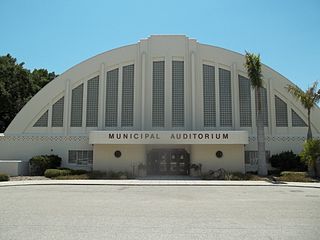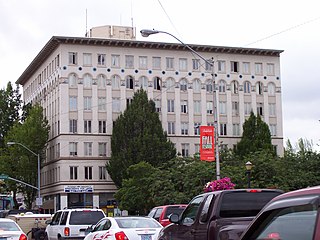
Kathryn Chicone Ustler Hall is a historic building on the campus of the University of Florida (UF) in Gainesville, Florida. It was designed by William Augustus Edwards in the Collegiate Gothic style and opened in 1919 as the University Gymnasium. In that capacity, the building was the first home of the Florida Gators men's basketball team, and it continued to serve as the home court for most of the university's indoor sports programs until the Florida Gymnasium opened in the late 1940s. The university became co-educational at about the same time, and the building was rechristened the Women's Gymnasium and was repurposed as a recreation center for the school's many new female students. On June 27, 1979, it was added to the U.S. National Register of Historic Places.

The Sarasota Municipal Auditorium, listed in the National Register as Municipal Auditorium-Recreation Club, is a historic multi-purpose facility built-in 1938. It is located at 801 Tamiami Trail North and is owned/operated by the municipal government of Sarasota, Florida. The auditorium has 10,000 square feet (930 m2) of exhibit space on its main floor and also contains an Art Deco style stage measuring 1,500 square feet (140 m2).

The Dalles Carnegie Library is a historic former library building located in The Dalles, Oregon, United States. It is one of the thousands of libraries whose construction was funded by Andrew Carnegie. The construction grant of $10,000 was approved in March 1907, and it was dedicated in September 1910.

Old Saint Peter's Landmark, commonly referred to simply as Old St. Peter's, is a historic building located at the corner of 3rd and Lincoln Streets in downtown The Dalles, Oregon, United States. It was built in 1897 and dedicated on March 17, 1898 as St. Peter's Church, and served the local Roman Catholic congregation as its place of worship until 1968. It was saved from scheduled demolition in 1971 by a group of concerned citizens who formed Old St. Peter's Landmark, Inc., for that specific purpose, and which maintains the building as a museum and site for weddings, concerts and other cultural events.

Washington High School was a high school in Portland, Oregon, United States, from 1906 to 1981. After fire destroyed the original building, a new building was completed in 1924. The school merged with Monroe High School in 1978 to become Washington-Monroe High School. The school closed shortly after in 1981. A few years later it was used as the Children's Services Center, a mulitpuropose social service facility that also provided day care and other programs for at risk youth. After that the building was vacant for many years. It was also used for a time as a location for administrative offices for the Portland Public Schools.

The Balch Hotel is a historic commercial lodging building in Dufur, Oregon, United States. It was built in 1907 by Charles Balch, a local land owner and businessman. The hotel has changed hands a number of times over the years, but it has remained in continuous use since it was constructed. Today, the Balch Hotel is an active hotel serving visitors to the Dufur area. Because of its importance to local history, the Balch Hotel is listed on the National Register of Historic Places.

Trevitt's Addition Historic District is a neighborhood, primarily residential in character, located in The Dalles, Oregon, United States. Victor Trevitt platted the first expansion of the original 1855 "Dalles City" townsite in 1860, and continued to extend his addition in response to economic developments. The district saw the first flour mill and electrical and water systems in The Dalles, one of the area's earliest Catholic churches, and direct connection to transportation networks including the Columbia River Highway and the railroad. Surviving buildings in the district reflect a continuous spectrum of architectural styles from 1864 to 1937.

The Original Wasco County Courthouse is a historic former courthouse, located in The Dalles, Oregon, United States. It is listed on the National Register of Historic Places under the name First Wasco County Courthouse, and is also listed as a contributing resource in the National Register-listed Trevitt's Addition Historic District.

The Wyandotte Odd Fellows Temple is a community building located at 81 Chestnut Street in Wyandotte, Michigan. It was listed on the National Register of Historic Places in 2009. As of 2010, the building serves as the Wyandotte Arts Center.

The Hotel Benton, or Benton Hotel, is a historic former hotel in Corvallis, Oregon, United States. Constructed from 1924 to 1925, the building represents a distinctive example of the Italian Renaissance style by Portland architects Houghtaling and Dougan. It is one of several Oregon buildings the firm designed in the revival styles popular in the 1920s and 1930s.

The Lewis Anderson House, Barn and Granary is a historic ensemble of buildings, currently located in The Dalles, Oregon, United States. This well-preserved set of 1890s Swedish American vernacular architecture was originally located on a farm on Pleasant Ridge, south of The Dalles. Lewis Anderson was a Swedish immigrant who, after establishing himself on Pleasant Ridge, worked semi-successfully to encourage further Swedish settlement in the area of The Dalles. The sidehill barn, with grade entrances on two levels, was the first erected of the ensemble, in 1890. The house was built by Anderson and fellow Swedish immigrant Ab Pearson in 1895. Anderson purchased and relocated the granary from a neighboring farm in 1898, in the process repurposing it from its previous function as a house.

Houghtaling & Dougan was an American architectural firm based in Oregon. It was a partnership of Chester A. Houghtaling and Luther Lee Dougan. A number of their works are listed on the U.S. National Register of Historic Places (NRHP).

The Orlando Humason House is a historic house located in The Dalles, Oregon, United States. Humason (1828–1875), the "Father of Wasco County", lived in this modest Gothic Revival house from its construction in 1860 until his death. Originally from Ohio, he worked in law, prospecting, agriculture, and journalism, prior to settling in The Dalles as a prosperous merchant and river transport businessman. Representing first Oregon City then The Dalles in the territorial and state legislatures, he introduced legislation establishing Wasco County, Multnomah County, and the City of The Dalles. He also championed a bill to build a canal around the Cascades Rapids to allow Lower Columbia shipping to reach The Dalles, which did not come to fruition in his lifetime. Humason's other public positions included mayor of The Dalles and Wasco County judge. The house is architecturally notable as one of very few Gothic Revival houses in The Dalles.

The Duluth Armory is a former armory and event venue in the East Hillside neighborhood of Duluth, Minnesota, United States. It was built in 1915 for the National Guard and naval militia, and expanded in 1941. From the beginning the National Guard also rented out the drill hall as an event venue, as it provided a larger and more flexible space than any other local venue until the construction of the Duluth Arena-Auditorium in 1966.

The former United States Post Office in The Dalles, Oregon, United States, is a historic building constructed in 1916. Executed from standardized federal plans in the Greek Revival style, it was the first federal building in The Dalles and one of a set of nine built in Oregon in the 1910s. It remained in operation as a post office longer than seven of the other eight in that group. The building was added to the National Register of Historic Places in 1985.

The Dalles Commercial Historic District comprises a primarily commercial and civic portion of downtown The Dalles, Oregon, United States. Strategically located at the eastern end of the Columbia River Gorge and near Celilo Falls, The Dalles became the preeminent transportation and trading hub of the interior Northwest in the 19th and early 20th centuries. The 46 historic buildings and other features of the district, built between 1860 and 1938, reflect the city's status and evolution as the gateway to the Columbia Plateau and the commercial, governmental, and cultural center of Eastern Oregon.

The Dalles Mint was to be a branch of the United States Mint in The Dalles in Oregon. Partially constructed in 1869, the planned two-story structure was never completed and the mint was never put into operation. Located in the downtown area of the city, the building was given to the state before it was sold to the public. The Mint building was most recently home to the Erin Glenn Winery.
Edward J. Hammond Hall is a historic mixed-use civic building on Main Street in Winter Harbor, Maine. The architecturally sophisticated hall was built in 1903 to house town offices and a performing arts spaces, and was built with a major donation from local son Edward J. Hammond. The building served as town hall until 1958, and is still used for performances by the Schoodic Arts for All organization. The building was listed on the National Register of Historic Places in 2004.



















